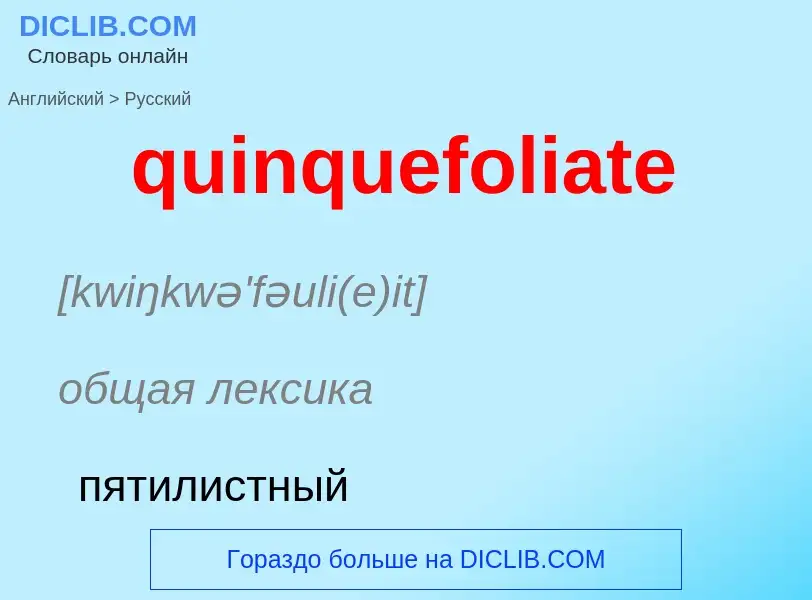Traducción y análisis de palabras por inteligencia artificial
En esta página puede obtener un análisis detallado de una palabra o frase, producido utilizando la mejor tecnología de inteligencia artificial hasta la fecha:
- cómo se usa la palabra
- frecuencia de uso
- se utiliza con más frecuencia en el habla oral o escrita
- opciones de traducción
- ejemplos de uso (varias frases con traducción)
- etimología
quinquefoliate - traducción al ruso
[kwiŋkwə'fəuli(e)it]
общая лексика
пятилистный
прилагательное
ботаника
пятилистный
[ləubd]
общая лексика
дольчатый
разделённый на лопасти
специальный термин
разделённый на доли
Смотрите также
прилагательное
специальный термин
дольчатый
разделённый на доли
Wikipedia
The following terms are used to describe leaf morphology in the description and taxonomy of plants. Leaves may be simple (a single leaf blade or lamina) or compound (with several leaflets). The edge of the leaf may be regular or irregular, may be smooth or bearing hair, bristles or spines. For more terms describing other aspects of leaves besides their overall morphology see the leaf article.
The terms listed here all are supported by technical and professional usage, but they cannot be represented as mandatory or undebatable; readers must use their judgement. Authors often use terms arbitrarily, or coin them to taste, possibly in ignorance of established terms, and it is not always clear whether because of ignorance, or personal preference, or because usages change with time or context, or because of variation between specimens, even specimens from the same plant. For example, whether to call leaves on the same tree "acuminate", "lanceolate", or "linear" could depend on individual judgement, or which part of the tree one collected them from. The same cautions might apply to "caudate", "cuspidate", and "mucronate", or to "crenate", "dentate", and "serrate."
Another problem is to establish definitions that meet all cases or satisfy all authorities and readers. For example, it seems altogether reasonable to define a mucro as "a small sharp point as a continuation of the midrib", but it may not be clear how small is small enough, how sharp is sharp enough, how hard the point must be, and what to call the point when one cannot tell whether the leaf has a midrib at all. Various authors or field workers might come to incompatible conclusions, or might try to compromise by qualifying terms so vaguely that a description of a particular plant practically loses its value.
Use of these terms is not restricted to leaves, but may be applied to morphology of other parts of plants, e.g. bracts, bracteoles, stipules, sepals, petals, carpels or scales. Some of these terms are also used for similar-looking anatomical features on animals.


![Oddly pinnate, pinnatifid leaves (''Coriandrum sativum'', [[coriander]] or cilantro) Oddly pinnate, pinnatifid leaves (''Coriandrum sativum'', [[coriander]] or cilantro)](https://commons.wikimedia.org/wiki/Special:FilePath/Cilantro leaf.jpg?width=200)





















.png?width=200)






































![petiole]] but no [[rachis]] (or rachillae) petiole]] but no [[rachis]] (or rachillae)](https://commons.wikimedia.org/wiki/Special:FilePath/Leaf morphology type ternately-compound palmate-ternate sessile.png?width=200)


.jpg?width=200)




